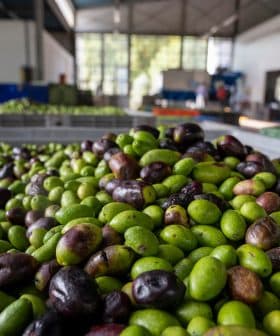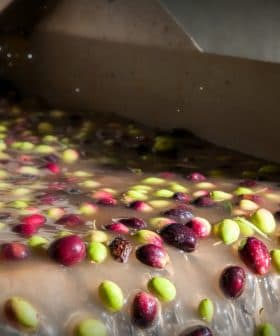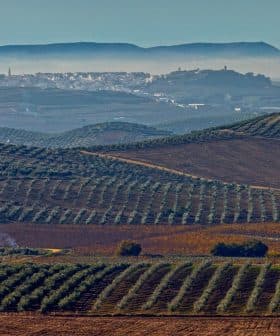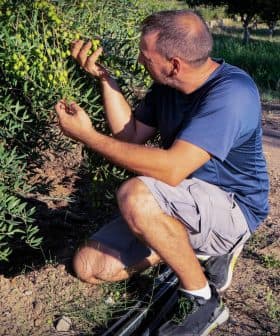Oregon Project Aims to Promote Olive Oil Sector
Local growers and researchers from Oregon State University are teaming up to solve some of the biggest problems facing the state's fledgling sector.
 Durant Vineyards. Photo by alanweinerphotography.com
Durant Vineyards. Photo by alanweinerphotography.comOregon State University has launched the Olea project to promote oliviculture in Oregon by determining the best propagation techniques, cultivars, and practices for olive growing in the state. Despite the challenges of Oregon’s climate, the project aims to help bolster the fledgling olive industry by providing valuable information to the public and potentially increasing commercial viability.
A new project launched by Oregon State University (OSU) aims to help spread oliviculture throughout California’s northern neighbor.
What OSU is doing is putting some scientific method behind the research. When you have that happening, we’re all going to benefit and I think people will start to become attracted to the tree as a commercially viable option.
The primary objectives of the Olea project will be to determine the most effective propagation techniques for olives in Oregon; identify which cultivars grow best in Oregon’s unique climate; assess the best transplanting and up-potting practices for achieving rapid orchard establishment; and making all of this information available to the public in order to help bolster the fledgling industry.
Sitting between 45 and 46 degrees of latitude, Oregon is located a bit farther north of other, more traditional, olive growing regions. However, growers and officials working on the Olea project believe that commercial olive growing can succeed here.
See Also:U.S. Olive Oil NewsWhile no official production statistics are currently being kept – something that Olea seeks to change – Paul Durant, the master miller at Durant Olive Mills, estimates that Oregon produced about 5,000 liters of olive oil last year. Durant has a general ideal about this figure since he runs the only commercial mill in the state.
Production has slowly grown since Oregonians first began growing olives commercially about 15 years ago. While the sector has not experienced the same kind of steady growth that California has achieved in that time, the number of acres of olive trees has crept up to about 100, all of which are located in the valleys west of the Cascade Range.
“I think we’ve experienced kind of incremental growth,” Durant told Olive Oil Times. “People have gotten in and then they’ve gotten out. Then other people have gotten in.”
The incremental nature of this growth, and the overall success of the olive growers, has a lot to do with weather patterns, according to Javier Fernandez-Salvador, an assistant professor at OSU and lead investigator on the Olea project.
“What we’ve found here in Oregon is that our yield and production depends a lot on the conditions of the previous season,” Fernandez-Salvador told Olive Oil Times. “If you look at the 2018 harvest, we had a really mild winter and then we also had lower precipitation, a drier spring and summer, which is good for pollination. A lot of our growers reported much higher yields than before.”
The previous few years have brought more mild winters, which has allowed some olive groves that were recently planted to go through a couple of production cycles.
“In Oregon, it’s not a matter of having a hot and dry summer,” Fernandez-Salvador said. “It’s about too much cold in the winter.”
When the first olive groves began popping up in Oregon 15 years ago, many producers simply imported olive trees from California, hoping to replicate the success olive growers were experiencing farther south.
“Unfortunately, that system does not work in Oregon,” Fernandez-Salvador said. “First of all because of our topography and second because of our climatic limitations.”
Serious freeze events in 2008, 2010 and 2013 wiped out many orchards and led those who remained to rethink their strategies.
In many ways, the evolution of the Oregonian olive oil sector resembles what happened with the Pinot Noir grape a quarter-century ago.
“Oregon was not a wine producing region 25 years ago and some growers started bringing cultivars and trying them and then found out that Pinot Noir thrived here,” Fernandez-Salvador said.
Oregon is now quite famous for its Pinot Noir grapes, which are cold tolerant enough to withstand the freezing winters. However, in order to succeed in growing the Pinot Noir grape, producers first failed with many other varieties.
Bogdan Caceu, the executive director of the Olive Growers of Oregon and an olive grower himself at La Creole Orchards, told a local agricultural publication that he believes olive oil can repeat the story of Pinot Noir.
In order to be successful, Caceu said that growers must find an olive cultivar that is more cold-tolerant than the ones grown in California, is characterized by early blooming and has exceptional sensorial qualities.
“If we check all those boxes, that’s the Pinot Noir of olives,” he said.
Fernandez-Salvador, however, believes in a more nuanced approach than simply finding the right cultivar.
“Unfortunately for Oregon, cultivars by themselves are not a silver bullet to be able to produce commercially here because of the physiology of the crop,” he said.
“Unlike in grapes, which are very cold tolerant, you just needed to find something that thrives with our shorter ripening and production season, but with olives the problem is not the ripening season,” he added. “The main problem is surviving the winter damage and establishing an orchard fast enough so that it is commercially viable.
However, some growers have found success with several varieties that were imported from colder regions. Fernandez-Salvador said that varieties from the north of Italy and south of France had so far shown quite a bit of promise. OSU is currently conducting field studies to determine which cultivars have the best chances of success in Oregon.
Durant, on the other hand, said that he has seen the most success with his three main Italian varieties.
“I am a big fan of Leccino, Frantoio and Picual,” he said. “They are probably my top three and they have been producing a good amount of fruit, which is obviously the key too. It’s one thing to survive, but can you also get a decent amount of fruit out of them.”
Olive oil production in Oregon is frequently a race against the clock. Olive trees tend to bloom in mid to late June and the earliest that the harvest can take place is in November, with olive growers remaining ever-vigilant of the prospect of the year’s first snowfall.
However, the vigilance and efforts of Oregonian producers often pay off in terms of quality. Durant said that Oregonian olive oils tend to have a unique flavor and high polyphenol count. Fernandez-Salvador said that tests of various olive oils done at the UC Davis Olive Center have confirmed this.
“I don’t know if it’s the extended ripening, we bloom really late compared with other climates, but the oil is phenomenally distinctive,” Durant said.
The high-quality end product, combined with strong demand for locally produced goods in Oregon, means that olive growing and oil producing can be quite profitable.
“Growers are looking at producing local market, high value products,” Fernandez-Salvador said. “Some are even selling 250 milliliter bottles for $40.”
And more people are showing interest in joining the sector as well. Fernandez-Salvador said that the state currently has about 10 to 12 commercial growers and about 15 to 20 smaller-scale growers.
“It’s a small industry, but the other week we held a grower meeting [at the university] and we had around 50 to 60 people,” he said.
Durant said that the Olea project should help the sector grow faster than its previous incremental rate and looks forward to a bigger and better Oregonian olive oil industry.
“I think it should grow faster. That’s my belief,” he said. “What OSU is doing is putting some scientific method behind the research. When you have that happening, we’re all going to benefit and I think people will start to become attracted to the tree as a commercially viable option.”









